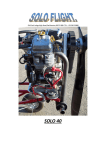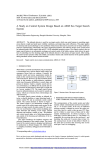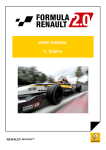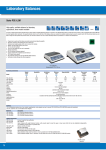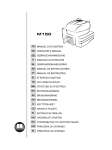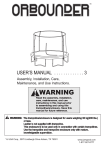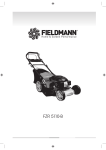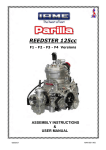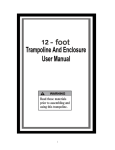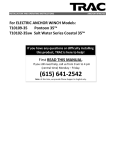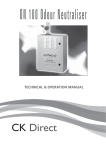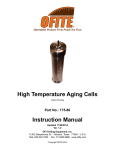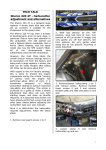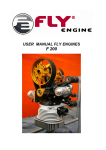Download CG um TRE_08-Cop - This website is under maintenance
Transcript
EN 1 TABLE OF CONTENTS 1. 2. 3. 4. 5. 6. 7. 8. General information ................................... Safety regulations ..................................... Components and controls ........................ What you need to know ............................ Standards of use ...................................... Maintenance ............................................. Troubleshooting ........................................ Technical data ........................................... 1 1 2 3 4 6 8 8 1. GENERAL INFORMATION 1.1 READING AND UNDERSTANDING THE MANUAL Some paragraphs in the manual containing information of particular importance for safety and operation are highlighted at various levels of emphasis, and signify the following: NOTE IMPORTANT or These give details or further information on what has already been said, and aim to prevent damage either to the engine or other damages. The number before the paragraph title refers to the text references and their related figures (shown inside front and back covers). 1.2 SAFETY SYMBOLS Your engine should be used with due care and attention. Symbols have therefore been placed on the engine to remind you of the main precautions to be taken. Their full meaning is explained later on. You are also asked to carefully read the safety regulations in the applicable chapter of this handbook. ! WARNING! Non-observance will result in the risk of injury to oneself or others. ! DANGER! Non-observance will result in the risk of serious injury or death to oneself or others. NOTE All indications, “front”, “rear”, “right” and “left”, are to be taken as referring to the engine positioned with the spark plug facing forwards with respect to the observer. 2. GENERAL SAFETY STANDARDS Warning! - Read and follow Operating Instructions before running engine. Warning! - Gasoline is flammable. Allow engine to cool at least 2 minutes before refuelling. Warning! - Engines emit carbon monoxide. DO NOT run in enclosed area. responsible for accidents or hazards occurring to other people or their property. (to be strictly applied) B) PREPARATION A) TRAINING 1) Carefully read the instructions contained in this manual and the instructions of the machine on which this engine is installed. Learn how to stop the engine quickly. 2) Never allow people unfamiliar with these instructions to use the engine. 3) Never use the engine while people, especially children, or pets are nearby. 4) Remember that the operator or user is 1) Do not wear loose-fitting clothing, dangling drawstrings, jewels or items that could become caught; tie up long hair and keep at safe distance while starting the lawnmower. 2) Turn engine OFF and let it cool before removing gas cap. 3) WARNING: DANGER! Fuel is highly flammable: – store the fuel in special containers; – refuel only outdoors by using a funnel; never smoke while refueling and/or handling fuel; 2 EN – add fuel before starting the engine. Never remove the cap of the fuel tank or add fuel while the engine is running or when the engine is hot; – if you have split some fuel, do not attempt to start the engine but move the machine away from the area of spillage and avoid creating any source of ignition until the fuel has evaporated and fuel vapours have dissipated. – always put the tank and fuel container caps back on and tighten well. 4) Replace faulty silencers and the guard, if damaged. 3. COMPONENTS AND CONTROLS 3.1 1. 2. 3. 4. 5. 6. ENGINE COMPONENTS Oil fillercap with dipstick Oil drain plug Air cleaner cover Fuel stopcock Spark plug cap Engine code ✍ Note your engine serial number here C) OPERATION 1) Do not operate the engine in a confined space where dangerous carbon monoxide fumes can collect. 2) Do not use starting fluids or similar products. 3) Do not change the engine governor settings or overspeed the engine. 4) Do not tilt the machine onto its side to prevent fuel leaks from the fuel tank cap. 5) Do not touch the cylinder fins and/or the silencer guard until the engine has cooled down. 6) Stop the engine and disconnect the spark plug cable before checking, cleaning or servicing the machine or the engine. 7) Do not crank the engine with spark plug removed. 8) Transport the machine with empty tank. 3.2 ACCELERATOR CONTROL The throttle trigger (generally a lever), fitted to the machine, is connected to the engine by a cable. Consult the machine’s Instructions Manual to identify the throttle trigger and its positions, usually marked by symbols, corresponding to: CHOKE = to be used for starting from cold. FAST = corresponds to maximum revs; to be used when working. SLOW = corresponds to minimum revs. D) MAINTENANCE AND STORAGE 1) A routine maintenance is essential for safety and for keeping a high performance level. 2) Do not store the machine with fuel in the tank in an area where the fuel vapours could reach an open flame, a spark or a strong heat source. 3) Allow the engine to cool before storing in any enclosure. 4) To reduce the fire hazard, keep the engine, the silencer and the fuel storage area free of grass, leaves, or excessive grease. 5) If the fuel tank has to be drained, this should be done outdoors once the engine has cooled down. 6)On safety ground, never use the engine with either worn or damaged parts. Parts are to be replaced and not repaired. Use genuine spare parts. Parts that are not of the same quality can damage the engine and impair your safety. EN 4. WHAT YOU NEED TO KNOW The engine performance, reliability and life are influenced by many factors, some external and some strictly associated with the quality of the products used and with the scheduled maintenance. The following information allow a better understanding and use of your engine. 4.1 ENVIRONMENTAL CONDITIONS The operation of a four-stroke endothermic engine is affected by: a) Temperature: – Working in low temperatures could lead to a difficult cold starting. – Working in very high temperatures could lead to a difficult hot starting due to the evaporation of the fuel either in the carburetor float chamber or in the pump. – In any case, the right kind of oil must be used, according to the operating temperatures. b) Altitude: – The higher the altitude (above sea level), the lower the max power developed by an endothermic engine. – When there is a considerable increase in altitude, the load on the machine should be reduced and particularly heavy work avoided. 4.2 FUEL 3 a) Use only detergent oil classified SF-SG. b) Choose the SAE viscosity grade of oil from this chart: – from 5 to 35 °C – from -15 to + 5 °C = SAE 30 = 5W-30 or 10W-30 (Multi-viscosity) – from -25 to + 35 °C = Synthetic oils 5W-30 or 10W-30 (Multi-viscosity) c) The use of multi-viscosity oils in hot temperatures will result in higher than normal oil consumption; therefore, check oil level more frequently. d) Do not mix oils of different brands and features. e) SAE 30 oil, if used below 5°C, could result in possible engine damage due to inadequate lubrication. f) Oil should be at “MAX” mark do not overfill. Overfilling with oil may cause: – Smoking; – Spark plug or air filter fouling, which will cause hard starting. 4.4 AIR FILTER The air filter must always be in perfect working order, to prevent debris and dust from getting sucked into the engine, reducing the efficiency and life of the machine. a) Always keep the filtering element free of debris and in perfect working order. b) If necessary, replace the filtering element with an original spare part. Incompatible filtering elements can impair the efficiency and life of the engine. c) Never start the engine without mounting the filtering element properly. A good quality fuel is the major issue for the engine reliability of operation. a) Use unleaded gasoline, with a minimum of 90 octane. b) Use clean, fresh fuel; purchase fuel in quantity that can be used within 30 days, to prevent gum from forming inside the container or the tank. c) Do not use fuel which contains Methanol. d) Do not add neither oil nor any kind of fuel additive. 4.3 OIL Use always high quality oils, choosing their viscosity grade according to the operating temperature. 4.5 SPARK PLUG Not all the spark plugs for endothermic engines are the same! a) Use only spark plugs of the recommended type, with the right heat range. b) Check the length of the thread, because – if too long – it will damage the engine beyond repair. c) Make sure that the electrodes are clean and their gap is correct. 4 EN 5. STANDARDS OF USE 5.1 BEFORE EVERY USE Before every use, perform the following checking procedures in order to assure a regular operation. 5.1.1 Check oil level See “Technical Data” chapter (8.1) for the fuel characteristics. Refuelling must be made when the engine is cold, following the instructions contained in the machine's Instructions Manual. 5.1.4 Spark plug cap Firmly connect the cable cap to the spark plug, making sure that there are no traces of dirt inside the cap and on the spark plug terminal. See the specific chapter (8.1) for the oil to be used. a) Place engine level. b) Clean around oil fill. c) Unscrew the cap , clean the end of the dipstick and insert it, as illustrated, without screwing iit down. d) Remove the cap with the dipstick and check the oil level that must be between the “MIN” and “MAX” marks. e) If oil is required, add oil of the same kind up to the “MAX” mark, being careful not to spill any outside the oil fill. f) Fully tighten the fillercap and wipe off any spilled oil. 5.2 STARTING THE ENGINE (cold) The engine must be started in the way described in the machine’s Instruction Manual, always making sure that any device (if present) that could cause the machine to advance or the engine to stop is disengaged. a) Open the fuel stopcock. b) Move the throttle to “CHOKE”. c) Turn the starter key as described in the machine’s instruction manual. After a few seconds, slowly move the throttle from “CHOKE” to either “FAST” or “SLOW”. 5.1.2 Check air cleaner The efficiency of the air filter is fundamental for the engine to work properly. Do not start the engine if the filtering element is missing or broken. a) Clean around the filter cover. b) Remove the cover by unscrewing the two knobs. c) Check the condition of the filtering element It must be intact, clean and in perfect working order; if not, either carry out maintenance or replace it. d) Put the cover back. NOTE If the engine starts but does not keep running, repeat the above steps with the throttle on “FAST”. 5.3 •) Follow the whole cold-starting procedure with throttle control in “FAST” position. 5.4 5.1.3 Adding fuel IMPORTANT Do not drip petrol onto the plastic parts of the motor or the machine to prevent damaging them and remove all traces of spilt petrol immediately. The warranty does not cover damage to plastic parts caused by petrol. STARTING THE ENGINE (hot starting) USE OF THE ENGINE IN OPERATION Maximum revs must be used to optimise the engine’s yield and performance, by setting the throttle trigger to “FAST”. ! WARNING! Keep your hands away from the silencer and surrounding areas that can become extremely hot. With the engine running, do not get loose-fitting clothing (ties, scarves, etc.) or hair closer to the top part of the engine. EN IMPORTANT Do not operate on over 20° inclines to prevent malfunctioning of the engine. 5.5 STOPPING MOWING THE ENGINE DURING a) Move the throttle to “SLOW”. b) Allow the engine to run at minimum speed for at least 15-20 seconds. c) Stop the engine following the instructions contained in the machine’s Instructions Manual. 5.6 STOPPING THE ENGINE AFTER MOWING a) Move the throttle to “SLOW”. b) Allow the engine to run at minimum speed for at least 15-20 seconds. c) Stop the engine following the instructions contained in the machine’s Instructions Manual. d) When the engine is cold, disconnect the spark plug and remove the starter key (if present). e) Close the fuel stopcock. f) Remove any debris from the engine and especially around the exhaust silencer to reduce the risk of fire. 5.7 CLEANING AND STORAGE a) Do not spray with water or use hydraulic lances to clean the exterior of the engine. b) Use a compressed air gun (max. 6 bars) for preference, thus preventing debris and dust from penetrating inside. c) Store the lawnmower (and the engine) in a dry place, sheltered from severe weather conditions and sufficiently ventilated. 5.8 LONG STORAGE (over 30 days) In case the engine has to be stored for a long time (for example at the end of the season), a few precautions are needed to help the future start-up. a) To prevent the formation of deposits inside the tank, empty it of fuel by unscrewing the carburettor float chamber plug and collect- 5 ing all the fuel in a suitable container. At the end of the operation remember to screw the plug back on and fully tighten it. b) Remove the spark plug and pour about 3 cl of clean engine oil into the spark plug hole, then, having blocked the hole with a rag, run the starter motor briefly to turn the engine for a few revs and distribute the oil over the inner surface of the cylinder. Finally replace the spark plug without connecting the cable cap. 6 EN 6.3 6. MAINTENANCE 6.1 See the specific chapter (8.1) for the oil to be used. SAFETY RECOMMENDATIONS ! WARNING! Remove the spark plug cap and read instructions before carrying out any cleaning, repair or maintenance operation. Wear proper clothing and working gloves whenever your hands are at risk. Do not perform maintenance or repair operations without the necessary tools and technical knowledge. IMPORTANT Never get rid of used oil, fuel or other pollutants in unauthorised places. 6.2 CHANGE OIL MAINTENANCE SCHEDULE Follow the hourly or calendar – whichever occur first – maintenance schedule shown in the following table. ! WARNING! Drain oil while the engine is warm, being careful not to touch the hot engine nor the drained oil. a) Place the machine on a flat surface. b) Clean the area around the filler cap and unscrew the cap with dipstick. c) Provide a suitable container for collecting the oil and unscrew the drain plug. d) Refit the drain plug and fully tighten it having imade sure that the gasket is in the right position. e) Fill up with fresh oil. f) Check that the oil level has reached the “MAX” notch on the dipstick. g) Close the cap again and clean up any traces of oil that was possibly spilt. After First 5 hours Every 5 hours or daily Every 50 hours or every season Every 100 hours NOTE Check oil level - ✔ - - Change oil ✔ - - ✔ Clean silencer and engine - ✔ - - Air filter cleaning and check - ✔ - - - - ✔ - Check spark plug - - ✔ - Replace spark plug - - - ✔ Fuel filter check - - - ✔ Operation 1) 2) Air filter replacement 2) 6.4 Change oil every 25 hours if the engine is operating under heavy load or in hot weather. Clean air cleaner more frequently if the machine is operating in dusty areas. 3) To be carried out by a specialized Centre. 1) 2) CLEAN SILENCER AND ENGINE Silencer must be cleaned when the engine is cold. a) Use a jet of compressed air to remove any debris and dirt that could cause a fire from the silencer and its protective cover. b) Make sure that the cooling air intakes are not blocked. c) Clean the plastic components with a sponge soaked in water and detergent. 6.5 3) The oil capacity is about 2.0 liter. AIR FILTER MAINTENANCE a) Clean the area around the filter cover. b) Remove the cover by unscrewing the two knobs. c) Remove the filtering element. d) Tap the cartridge on a solid surface and blow it from the inside with compressed air to remove dust and debris. EN IMPORTANT Do not use water, petrol, detergents or any other products to clean the cartridge. IMPORTANT The sponge pre-filter must NEVER be oiled. e) Clean the inside of the filter housing from dust and debris, making sure to block the inlet duct with a rag to prevent them from entering the engine. f) Remove the rag, install the filtering element in its housing and refit the cover. 6.6 SPARK PLUG SERVICE a) Remove the spark plug using a spark plug socket wrench. b) Clean the electrodes with a metal brush and remove any carbonaceous build-up. c) Using a thickness gauge, check for the right gap (0.6-0.8mm) between the electrodes. d) Install the spark plug and tighten with a socket wrench. Replace the spark plug if the electrodes are burnt or if the porcelain is broken or damaged. ! WARNING! Fire hazard! Do not check the ignition system with spark plug removed. IMPORTANT Use only spark plugs of the recommended type. 6.7 TUNING THE THROTTLE CABLE AND THE CARBURETTOR Should the engine not reach maximum revs with the throttle trigger set to “FAST”, it could be due to the throttle trigger and speed control lever being out of phase or to a carburetion problem. Go to a specialised Centre or contact your Dealer to restore normal operation. 7 8 EN 7. TROUBLESHOOTING PROBLEM a) Hard starting b) Inconsistent working c) Loss of power whilst operating LIKELY CAUSE SOLUTION – No fuel – Check and top up – Stale fuel or build-ups in tank – Empty fuel tank and refill with fresh fuel – Incorrect starting procedure – Perform the starting procedure correctly – Spark plug disconnected – Check that the spark plug cap fits well over the plug terminals – The spark plug is wet or the spark plug electrodes are dirty or placed inadequately – Check – Air filter clogged – Check and clean – Incorrect oil for the season – Replace with proper oil – Fuel evaporation in the carburetor (vapor lock) due to high temperatures – Wait for a few minutes then start again – Fault in carburation – Contact a Licensed Service Centre – Hard starting – Contact a Licensed Service Centre – Dirty electrodes or incorrect gap – Check – The spark plug cap is inserted incorrectly – Check that the cap is fitted correctly – Air filter clogged – Check and clean – Throttle trigger in “CHOKE” position – Move the lever to the “FAST” position – Fault in carburation – Contact a Licensed Service Centre – Fault in ignition – Contact a Licensed Service Centre – Air filter clogged – Check and clean – Fault in carburation – Contact a Licensed Service Centre – Governor out of phase with respect to the accelerator – Adjust the cable 8. TECHNICAL SPECIFICATIONS 8.1 REFILLING AND OPERATION MATERIALS Fuel .......................................................................................... Unleaded gasoline, minimum 90 octane Engine oil: from 5 to 35 °C......................................................................................................... SAE 30 from -15 to +5 °C .................................................................................... 5W-30 or 10W-30 from -25 to +35 °C .................................................................. Synthetic 5W-30 or 10W-30 Oil capacity .................................................................................................................................. 2.0 liter Spark plug ................................................................................................ F7TRC (NHSP) or equivalent Spark plug gap ................................................................................................................... 0.6 - 0.8 mm











